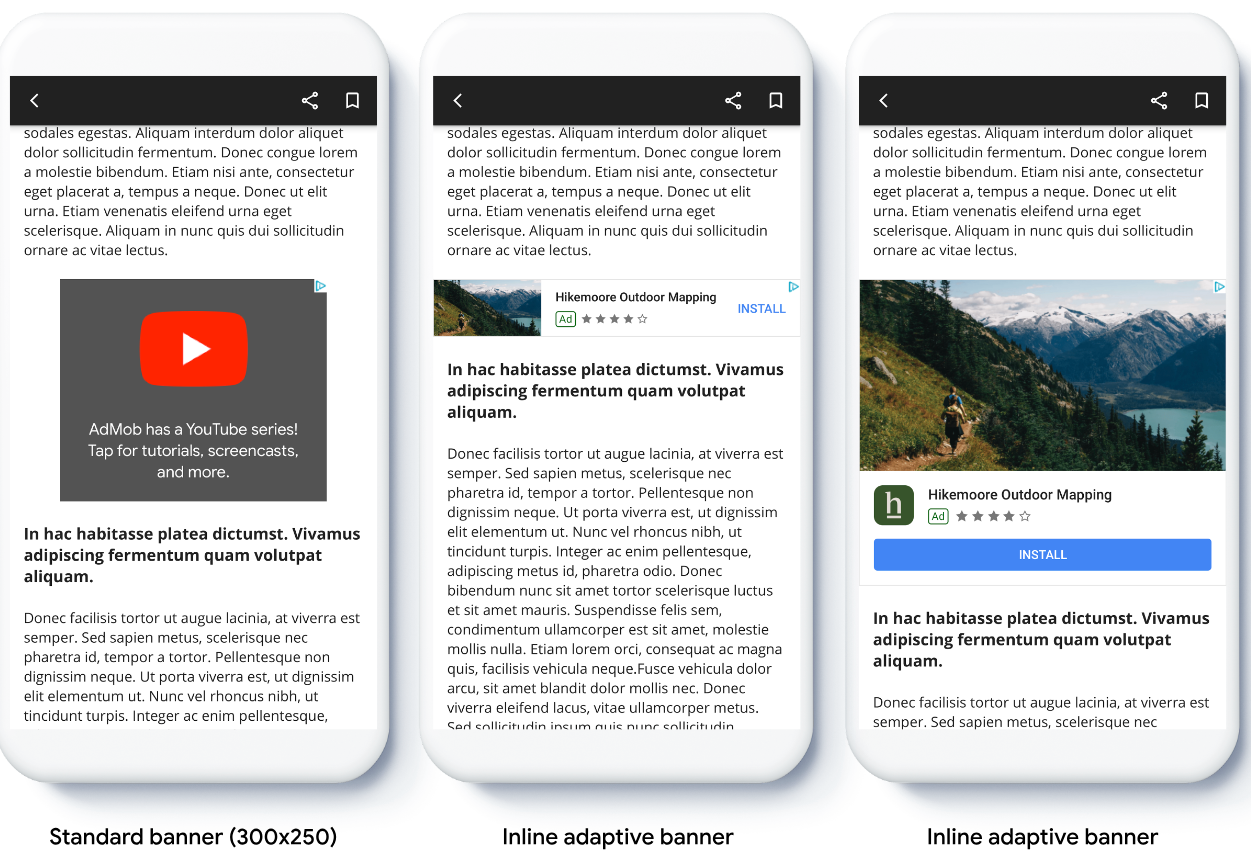Banery adaptacyjne pozwalają określić szerokość reklamy, aby wyznaczyć optymalny rozmiar reklamy. Banery adaptacyjne zwiększają też skuteczność kampanii dzięki optymalizacji rozmiaru reklamy na każdym urządzeniu. Dzięki temu możesz zwiększyć skuteczność.
W porównaniu z zakotwiczonymi banerami adaptacyjnymi banery adaptacyjne śródtekstowe są większe i wyższe, a zamiast stałej wysokości używają zmiennej. Banery adaptacyjne wstawiane w treść mają zmienną wysokość i mogą zajmować cały ekran lub maksymalną wysokość określoną przez Ciebie.
Śródtekstowe banery adaptacyjne umieszcza się w treściach, które można przewijać, np.:

Zanim zaczniesz
Zanim przejdziesz dalej, zapoznaj się z przewodnikiem dla początkujących Reklamy banerowe.
Wdrażanie banerów adaptacyjnych
W odróżnieniu od zakotwiczonych banerów adaptacyjnych wbudowane banery adaptacyjne wczytują się w rozmiarze wbudowanego banera adaptacyjnego. Aby utworzyć wbudowany adaptacyjny rozmiar reklamy, wykonaj te czynności:
Pobierz szerokość używanego urządzenia lub ustaw własną szerokość, jeśli nie chcesz używać pełnej szerokości ekranu.
Kotlin
private val adWidth: Int get() { val displayMetrics = resources.displayMetrics val adWidthPixels = if (Build.VERSION.SDK_INT >= Build.VERSION_CODES.R) { val windowMetrics: WindowMetrics = this.windowManager.currentWindowMetrics windowMetrics.bounds.width() } else { displayMetrics.widthPixels } val density = displayMetrics.density return (adWidthPixels / density).toInt() }Java
public int getAdWidth() { DisplayMetrics displayMetrics = getResources().getDisplayMetrics(); int adWidthPixels = displayMetrics.widthPixels; if (VERSION.SDK_INT >= VERSION_CODES.R) { WindowMetrics windowMetrics = this.getWindowManager().getCurrentWindowMetrics(); adWidthPixels = windowMetrics.getBounds().width(); } float density = displayMetrics.density; return (int) (adWidthPixels / density); }Aby uzyskać obiekt rozmiaru reklamy adaptacyjnej w formacie inline dla wybranej orientacji, użyj metody statycznej w klasie rozmiaru reklamy:
Kotlin
val adView = AdView(this@MainActivity) adView.setAdSize(AdSize.getCurrentOrientationInlineAdaptiveBannerAdSize(this, adWidth))Java
final AdView adView = new AdView(MainActivity.this); adView.setAdSize(AdSize.getCurrentOrientationInlineAdaptiveBannerAdSize(this, getAdWidth()));Podczas wdrażania banerów adaptacyjnych w aplikacji pamiętaj o tych kwestiach:
- Rozmiary adaptacyjnych banerów śródtekstowych działają najlepiej, gdy wykorzystują całą dostępną szerokość. W większości przypadków jest to pełna szerokość ekranu używanego urządzenia lub pełna szerokość treści nadrzędnych banera. Musisz znać szerokość widoku, który ma się pojawić w reklamie, szerokość urządzenia, szerokość treści nadrzędnej i odpowiednie obszary bezpieczne.
Określanie orientacji rozmiaru wbudowanego banera adaptacyjnego
Aby wstępnie wczytać śródtekstowy adaptacyjny baner reklamowy w określonej orientacji, użyj tych metod:
AdSize.getPortraitInlineAdaptiveBannerAdSize(Context context, int width)AdSize.getLandscapeInlineAdaptiveBannerAdSize(Context context, int width)
Jeśli Twoja aplikacja obsługuje widok pionowy i poziomy, a chcesz wstępnie wczytać baner adaptacyjny w bieżącej orientacji, użyj tego kodu:
AdSize.getCurrentOrientationInlineAdaptiveBannerAdSize(Context context, int width)Ta metoda wczytuje reklamę w bieżącej orientacji.Ograniczanie wysokości wbudowanego banera adaptacyjnego
Domyślnie wbudowane banery adaptacyjne utworzone bez wartości
maxHeightmają wartośćmaxHeightrówną wysokości urządzenia. Aby ograniczyć wysokość adaptacyjnego banera śródtekstowego, użyj metodyAdSize.getInlineAdaptiveBannerAdSize(int width, int maxHeight).Dodatkowe materiały
Przykłady w GitHubie
Pobierz przykładową aplikację, aby zobaczyć, jak działają śródtekstowe banery adaptacyjne.
